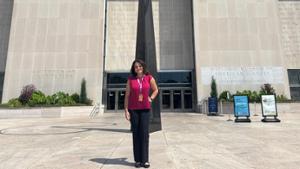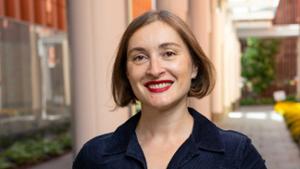
Art History
The goal of the Art History Department is to equip students with a critical understanding of the historical and theoretical concerns that have shaped the production, circulation, and reception of art, visual culture, and architecture over time and around the world.
About the Major
Art History encompasses the study of visual and material culture, performance, and the built environment across geographies, media, and technologies. The transdisciplinary nature of art and architectural history allows students to draw upon a broad range of subjects and approaches that span the humanities, social sciences, and sciences. Concentrators hone skills in visual literacy, critical thinking, written and oral communication, and engage with innovative digital technologies. Many of our courses provide students with opportunities for experiential and project-based learning, from working with collections at the Wellin Museum and Burke Library, to field trips to regional museums and historical sites, to creating virtual exhibitions and digital visual narratives.
Students Will Learn To:
- Analyze material and visual culture and/or the built environment as a form of visual literacy
- Apply art historical and interdisciplinary methods of analysis to the study of material and visual culture and/or the built environment
- Draw connections between the past and present to illuminate the relevance of both
- Identify how particular scholarly discourses and practices have contributed to social, structural, and institutional hierarchies in art history’s own history
A Sampling of Courses

Ways of Seeing: Vision, Technology, Media
An introduction to the study of media with a focus on visual media and experience. Students will learn about key moments in media history, from the invention of print to the rise of broadcasting/mass media and the entrenchment of digital/social media. Students will engage with foundational concepts in media and visual studies, and develop tools to critically analyze, discuss, and write about the images that come to us through physical and virtual networks. Topics include: photojournalism, infographics, screen cultures, public relations and advertising, social media, AI, and the effects of digital media on the environment and mental health.
Explore these select courses:
This class involves the study of the formless divine and the corporeal nature of the body in South and Southeast Asian art. We will examine representations of the Buddha, the Jina, gods and goddesses, queens and kings, and an array of apotropaic motifs in sacred art and architecture from India, Sri Lanka, Cambodia, and Indonesia. Case studies are chosen from a period spanning over two thousand years, beginning with the third century BCE and ending with portrayals of the divine in contemporary art.
This course surveys the art and architecture of Europe during the Middle Ages from ca. 500-1400. We will focus on key artworks and monuments made and built in Europe from the Visigoths and Vikings to the Valois court, as well as examine cross-cultural interactions across religious and political boundaries in medieval Africa, the Arctic, and the Mediterranean. Students will develop an awareness of the production, function, and social context of medieval visual culture through the close study of architecture, manuscript, metalwork, mosaic, painting, sculpture, and textile. Despite our historical distance from the Middle Ages, we will also consider how medieval imagery remains relevant to our current visual world.
Art & Social Change explores the history of artistic production as political activism. From the early efforts of painters, sculptors, and photographers in the nineteenth century to more recent developments in experimental media, artists have offered not only social critique but also attempted direct political intervention. Whether addressed to issues of race, class, gender, globalization, or ecological precarity, this course grapples with art’s ability to affect social change.
This course examines architecture’s historical relationship with the environment by engaging with broad Anthropocene questions. We will trace changing conceptions of "nature" through the study of the co-production of architecture and the environment, and the ways in which designers continually reconceive the human-nature relationship. Topics include colonial land management, materiality, infrastructure and resource extraction (eg. Erie Canal, dams, solar farms), waste, architecture of logistics (eg. Walmart and Amazon), eco-cities and sustainable urbanism, and landscapes of food production.
Meet Our Faculty
Nathan Goodale
William R. Kenan Jr. Professor of Anthropology, Associate Provost, Co-Director of Geoarchaeology
complex hunter-gatherers in the interior Pacific Northwest; the forager/farmer transition in Southwest Asia; rural coastal adaptations in western Ireland
History of photography; photojournalism and news media; modern and contemporary visual culture; media studies; digital humanities; World War II and the Holocaust; Jewish Studies
Art and visual culture since 1950; performance art; trauma studies; gender in visual studies; economic histories of the arts
South Asian art; visual culture of Indian Ocean trade; churches, mosques, synagogues, and temples in Kerala; syncretism; religious iconography; artistic agency; digital art history
Medieval and early modern art; Scandinavian studies; German studies; economics and trade; religious iconography; object-based learning; history and methods of art history
Islamic art and architecture, art historiography and methodology, postcolonial theory, Late Antiquity and Early Islam, urban studies and art history, contemporary/historical interfaces
19th and 20th century European and American painting and sculpture
Faces & Spaces


Careers After Hamilton
Hamilton graduates who concentrated in art history are pursuing careers in a variety of fields, including:
- Account Manager, Sotheby’s
- Vice President and Real Estate Counsel, Lehman Brothers
- Cataloguer, Lang Antiques
- President, McGraw-Hill Professional
- Sales Manager, NBC News
- Senior Vice President, William Doyle Galleries
- Tour Coordinator, Academic Arrangements Abroad
- Presidential Innovation Fellow, The White House
- President, Nye & Co. Auctioneers
Explore Hamilton Stories

Bringing 250 Years of U.S. History to Life at the Smithsonian
Art history student Lily Watts ’26 spent her summer on the National Mall working as a curatorial exhibition development intern at the Smithsonian’s National Museum of American History.

Bair Presents in Toronto, Germany, and Switzerland
Assistant Professor of Art History Nadya Bair recently presented “Photography Exhibitions and the Magnum Brand” at the Image Centre at Toronto Metropolitan University.
Contact
Department Name
Art History Department
Contact Name
Nathan Goodale, Chair
Clinton, NY 13323










